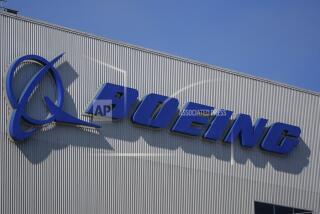California Largely Unscathed in Lockheed Cuts : Defense: The aerospace giant will close 12 plants and trim 12,000 jobs worldwide. But its Sunnyvale facility will remain intact.
- Share via
Lockheed Martin Corp. will close 12 plants and slash 12,000 jobs worldwide under a massive streamlining plan announced Monday, but the aerospace giant’s 600-acre missile and space factory in Sunnyvale, Calif., will be spared.
The company’s overall presence in the state, in fact, will remain mostly intact--one of the few times in the post-Cold War era that California’s battered aerospace industry has had anything to cheer about. Lockheed Martin’s statewide employment, now 23,000, will drop only 3% to 22,250 under the new plan--though in a measure of how much the industry has already scaled back, Sunnyvale’s plant alone employed more than 23,000 in the mid-1980s.
The cuts unveiled Monday are part of the fallout from the historic, $10-billion merger of Lockheed Corp. and Martin Marietta Corp. completed three months ago. The deal created the nation’s largest defense contractor, with $23 billion in annual sales, and marked the end of Lockheed’s decades-long reign as a California-based institution.
The new Lockheed Martin had been expected to shed production and office space it doesn’t need--including the old Lockheed headquarters in Calabasas--eliminate duplicate field and marketing offices, and consolidate overlapping manufacturing programs, especially in the missile and space area.
Lockheed Martin officials had predicted at the time of the merger that layoffs would occur, though they contended that because of reduced Pentagon spending, more of their workers would have been laid off over the next few years had the companies stayed independent.
The program announced Monday, to be implemented over the next five years, will save $1.8 billion a year in operating costs, the company said.
In addition to the expected closure of Calabasas--the new company is based in Bethesda, Md.--a small aircraft services site in Chino will be shuttered. But in addition to the Sunnyvale plant, the company will keep its top-secret “Skunk Works” aircraft-design group in Palmdale (3,700 workers), its aircraft maintenance operation in Ontario (1,700) and its CalComp computer graphics unit in Anaheim (500).
Lockheed Martin will close two of its four missile and space plants. But the losers are on the East Coast: a facility in East Windsor, N.J., which has 3,100 workers and traces its lineage to the former RCA Corp., and one in Valley Forge, Pa., which has 1,800 workers and was originally started by General Electric Co.
Roughly 1,500 of the employees from those plants will be transferred to California and another 1,000 will be assigned to a new business unit in Pennsylvania, Lockheed Martin Chairman Daniel Tellep said in a telephone interview.
Other facilities to be closed are in Austin and Abilene, Tex.; Tucson; Utica, N.Y., and Ottawa, Canada.
Lockheed Martin’s Sunnyvale/Bay Area work force, now at 10,400, is not expected to grow. The extra workers transferred from the two closed plants will be offset by other planned cuts in Bay Area employment, the company said.
Indeed, in addition to the 12,000 jobs Lockheed Martin plans to eliminate under the plan, another 7,000 positions are being phased out companywide under previously planned cutbacks linked to the decline in U.S. defense and civil space budgets.
But the job cuts announced Monday are not as deep as some analysts had expected.
“They really minimized the layoffs,” said Wolfgang Demisch, an analyst with BT Securities Corp. in New York. “I was figuring it would be a 15% to 20% cut.”
As it turned out, the 12,000 jobs represent 9% of Lockheed Martin’s 130,000 total jobs outside its contracts to operate government-owned nuclear weapons plants. The firm manages another 40,000 workers at three such operations.
The decision to keep Sunnyvale open means California plants will account for virtually all U.S. production of communications satellites. The other two major players in that industry are Loral Corp.’s Palo Alto plant and Hughes Electronics Corp.’s site in El Segundo.
The move was greeted with relief in Sunnyvale, where officials had braced for the possibility that their plant, built in 1956, might be the one shuttered.
“I’m delighted, to say the least,” Mayor Barbara Waldman said. “The Sunnyvale/Bay Area is a very valuable resource . . . and this shows that Lockheed thinks so too.”
But some Lockheed Martin workers in Sunnyvale, having already survived waves of layoffs in their industry, had a more subdued reaction to the news.
“I’m not surprised,” said engineer Laury Smith as he lunched at a restaurant near the plant. “I think we have unique capabilities here, both in terms of the people and the technology.”
Another employee, who asked not to be identified, said the news offered little respite from the constant fear of layoffs. “We’ve been living under this cloud since the Berlin Wall came down” in 1989, he said.
Tellep said Lockheed concluded it would be too costly and difficult to close its two biggest space plants: the Sunnyvale site and one in Denver that makes government satellites and launchers.
“It is better to relocate the smaller operations into the bigger operations,” said Tellep, who earlier in his career was in charge of the Sunnyvale operation. “The underlying objective was to find the most competitive arrangement that would reduce our costs the most.”
The Sunnyvale site builds the Trident II ballistic missiles, the Milstar defense communications satellites and components for the proposed space station.
After the announcement, Lockheed Martin’s stock fell $2 to $61.625 a share in New York Stock Exchange trading.
Times staff writer Julie Pitta in Sunnyvale contributed to this report.
More to Read
Inside the business of entertainment
The Wide Shot brings you news, analysis and insights on everything from streaming wars to production — and what it all means for the future.
You may occasionally receive promotional content from the Los Angeles Times.










